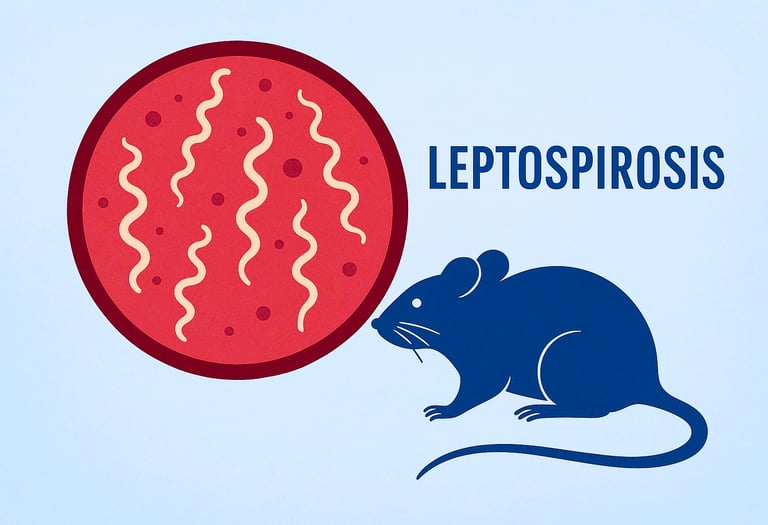Stay updated on what is trending in health. Discover tips and resources for a healthier, balanced life.
Leptospirosis: What You Need to Know About This Rat-Linked Disease
Leptospirosis is a serious bacterial infection spread through water or animals. Learn how it spreads, symptoms to watch for, and easy ways to protect yourself—especially during floods or outdoor activities.
DISEASES AND CONDITIONS
Dr. S. Ali
7/29/20255 min read


Have you ever heard of leptospirosis? If not, you're not alone. It’s one of those infections that flies under the radar—until it hits. Caused by bacteria found in animal urine (especially rats), this disease can range from mild flu-like symptoms to severe illness affecting your liver, kidneys, and even your brain.
Let’s break it down in simple terms—what it is, how you get it, and most importantly, how to protect yourself.
What Exactly Is Leptospirosis?
Leptospirosis is a bacterial infection caused by spiral-shaped bacteria called Leptospira. You can catch it through contact with water, soil, or food that’s been contaminated with urine from infected animals—usually rodents, farm animals, or dogs.
And it’s not just a problem in rural farms or forests. Urban areas with poor sanitation and flooding are also hotspots.
How Do You Get It?
The bacteria enter your body through cuts in the skin or through mucous membranes like your eyes, nose, or mouth. Common ways people get infected include:
Wading in floodwater or swimming in rivers/lakes with contaminated water
→ Leptospira bacteria thrive in warm, stagnant water—especially after floods. Even a small splash into the eyes or mouth can be enough to cause infection.Walking barefoot or with exposed skin in muddy or wet environments
→ The bacteria can sneak in through even the tiniest cracks or blisters on your skin. Protective footwear is your first line of defense.Handling animals or cleaning up rodent-infested areas
→ Rats and other rodents often carry the bacteria without showing symptoms. Cleaning up their mess without gloves can put you at serious risk.Drinking contaminated water
→ In areas without clean water, even a sip from a contaminated stream or puddle can make you sick. Boil or filter your water when in doubt.
It usually takes about 5 to 14 days after exposure for symptoms to start—but it can take up to a month, making it tricky to trace back the source.
What Are the Symptoms?
Leptospirosis symptoms can vary widely, from mild to severe. Some people don’t even realize they have it, mistaking it for the flu. Here’s what to watch out for:
Early Symptoms:
Fever
→ One of the first signs. It often comes on suddenly and can be quite high, leaving you feeling wiped out.Headache
→ This isn’t just a dull ache—it can be intense and persistent, especially behind the eyes.Muscle aches (especially in the calves and lower back)
→ These can feel deep and painful, almost like a cramp that won’t go away.Chills
→ You might feel cold and shaky even when the weather’s warm—a classic infection response.Red eyes
→ Eye redness without discharge is a hallmark of leptospirosis and often overlooked.Vomiting or diarrhea
→ GI symptoms may make you think it’s just a stomach bug, but they’re part of the early infection picture.
These early symptoms usually last about a week and may go away on their own. But in some cases, the infection comes back stronger—affecting vital organs.
Severe Leptospirosis (Weil’s Disease):
If the infection spreads to organs, it can become life-threatening. Symptoms may include:
Yellowing of the skin or eyes (jaundice)
→ This means your liver is struggling—get medical help fast if you notice yellowing.Kidney failure
→ You may notice reduced urination, swelling in your legs, or extreme fatigue.Liver damage
→ Along with jaundice, you might feel abdominal pain and a sense of fullness in your upper belly.Bleeding from the lungs
→ This rare but serious complication can cause coughing up blood and difficulty breathing.Meningitis (inflammation of the brain and spinal cord)
→ Headache, stiff neck, confusion, or sensitivity to light are red flags for brain involvement.
In severe cases, hospitalization is a must—and without treatment, complications can quickly become fatal.
Who’s Most at Risk?
While anyone can get leptospirosis, you’re more at risk if:
You live in or travel to tropical climates or areas with poor sanitation
→ Frequent flooding, poor drainage, and overcrowded conditions make it easier for the bacteria to spread.You work with animals (like farmers, vets, or slaughterhouse workers)
→ Regular contact with animal urine or tissues increases your chances of coming into contact with Leptospira.You take part in outdoor activities like hiking, fishing, or swimming in freshwater lakes
→ Nature lovers are at risk, especially if they go barefoot or swim in unfamiliar waters.You clean or spend time in rodent-infested spaces
→ Urban outbreaks are often linked to poor housing conditions, basements, or food storage areas with rat activity.
How Is It Diagnosed?
Your doctor may suspect leptospirosis based on your symptoms and possible exposure. Blood or urine tests can confirm the diagnosis. Sometimes multiple tests are needed to catch the bacteria or detect antibodies your body produces in response.
How Is It Treated?
The good news? Leptospirosis is treatable—especially if caught early. Doctors usually prescribe antibiotics such as doxycycline or penicillin to kill the bacteria.
For severe cases, hospitalization, IV antibiotics, and supportive care (like dialysis or oxygen) may be needed.
Can You Prevent It?
Absolutely. The key is avoiding exposure and protecting yourself in high-risk environments. The good news? Most cases of leptospirosis are totally preventable with a few smart precautions.
Prevention Tips:
Don’t swim or wade in potentially contaminated water
→ If you're unsure about the water quality, skip the swim. Even a short dip in floodwaters or stagnant lakes can put you at risk.Wear boots and gloves if you’re cleaning up animal droppings or flood debris
→ Protective gear creates a barrier between you and contaminated materials. It’s especially important during flood cleanup or in rodent-prone buildings.Keep rodent populations under control
→ Rats are major carriers of leptospira bacteria. Seal up food containers, fix leaks, and keep your home or workplace clean to discourage them.Drink clean, filtered water
→ Always treat water from natural sources before drinking. Boiling, filtering, or using purification tablets can make it safe.Avoid walking barefoot in muddy or wet areas
→ Even small cuts or scrapes on your feet can let bacteria in. Closed shoes or waterproof boots are your best bet in risky environments.Get your pets vaccinated—especially dogs who go outdoors
→ Dogs can pick up and spread the bacteria. Keeping them vaccinated helps protect the whole household.
Bonus tip: Some countries also offer preventive antibiotics (like doxycycline) if you're entering a high-risk zone—this is common for soldiers, humanitarian workers, or travelers during flooding season.
Final Thoughts
Leptospirosis may not be a household name, but it’s a serious illness that’s on the rise—especially in areas prone to flooding or poor sanitation. The good news? With awareness, proper hygiene, and a little precaution, it’s completely preventable.
If you’ve recently had contact with floodwater or suspect exposure and start feeling sick, don’t wait—see a doctor early.
Stay informed. Stay safe. And keep those shoes on when you head outdoors!
Sources
World Health Organization (WHO) – Leptospirosis Fact Sheet
https://www.who.int/news-room/fact-sheets/detail/leptospirosis
Centers for Disease Control and Prevention (CDC) – Leptospirosis
https://www.cdc.gov/leptospirosis/index.html
Mayo Clinic – Leptospirosis Overview
https://www.mayoclinic.org/diseases-conditions/leptospirosis/symptoms-causes/syc-20351220
MedlinePlus – Leptospirosis
https://medlineplus.gov/leptospirosis.html
National Institute for Health and Care Excellence (NICE) – Leptospirosis Guidelines
https://cks.nice.org.uk/topics/leptospirosis/
Pulse Your Health
Empowering you to achieve your health goals.
Contact
© 2025. All rights reserved.
Disclaimer: The content on this website is for informational purposes only and is not medical advice. Always seek the advice of your physician or other suitably qualified healthcare professional for diagnosis, treatment and your health related needs.
